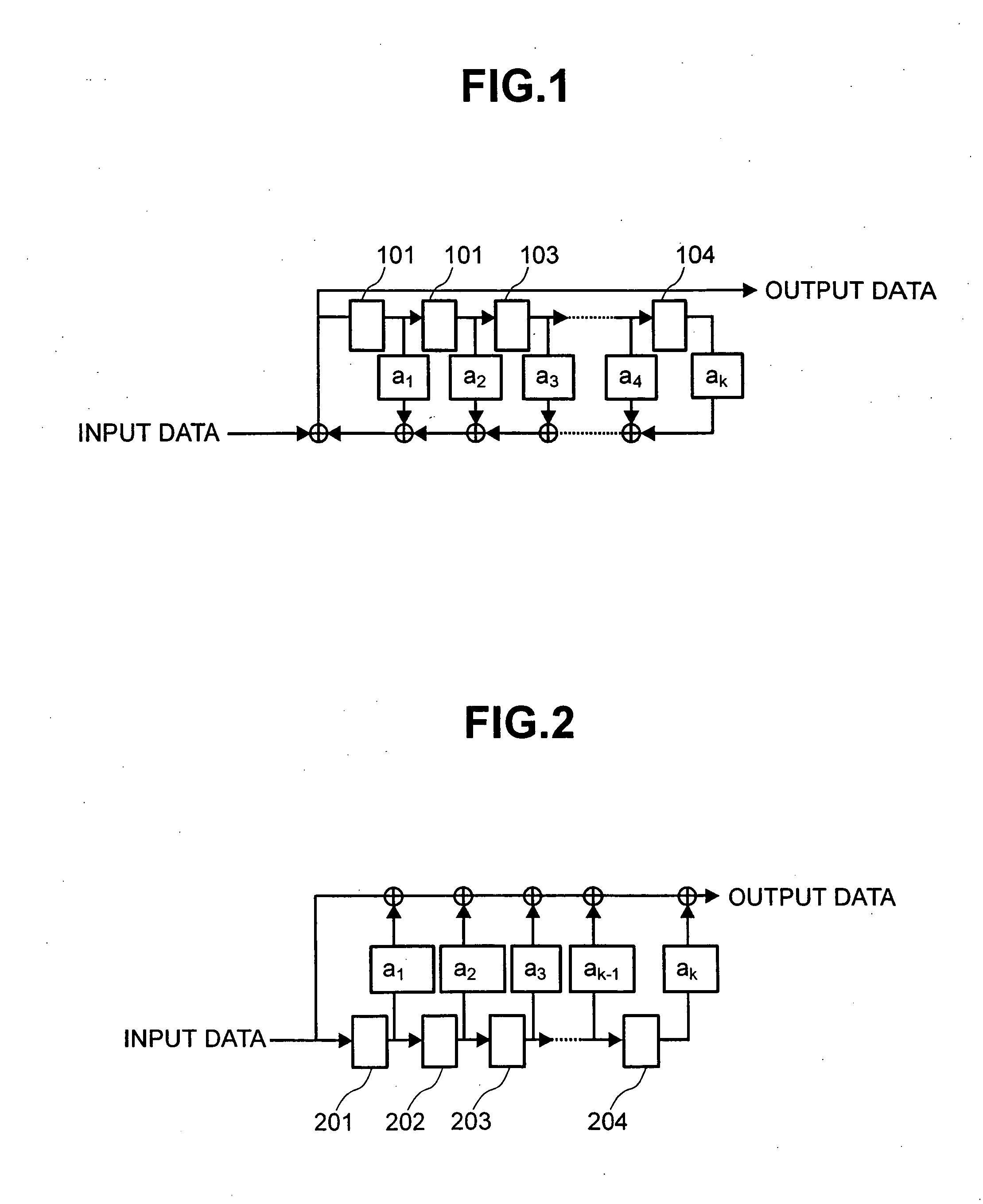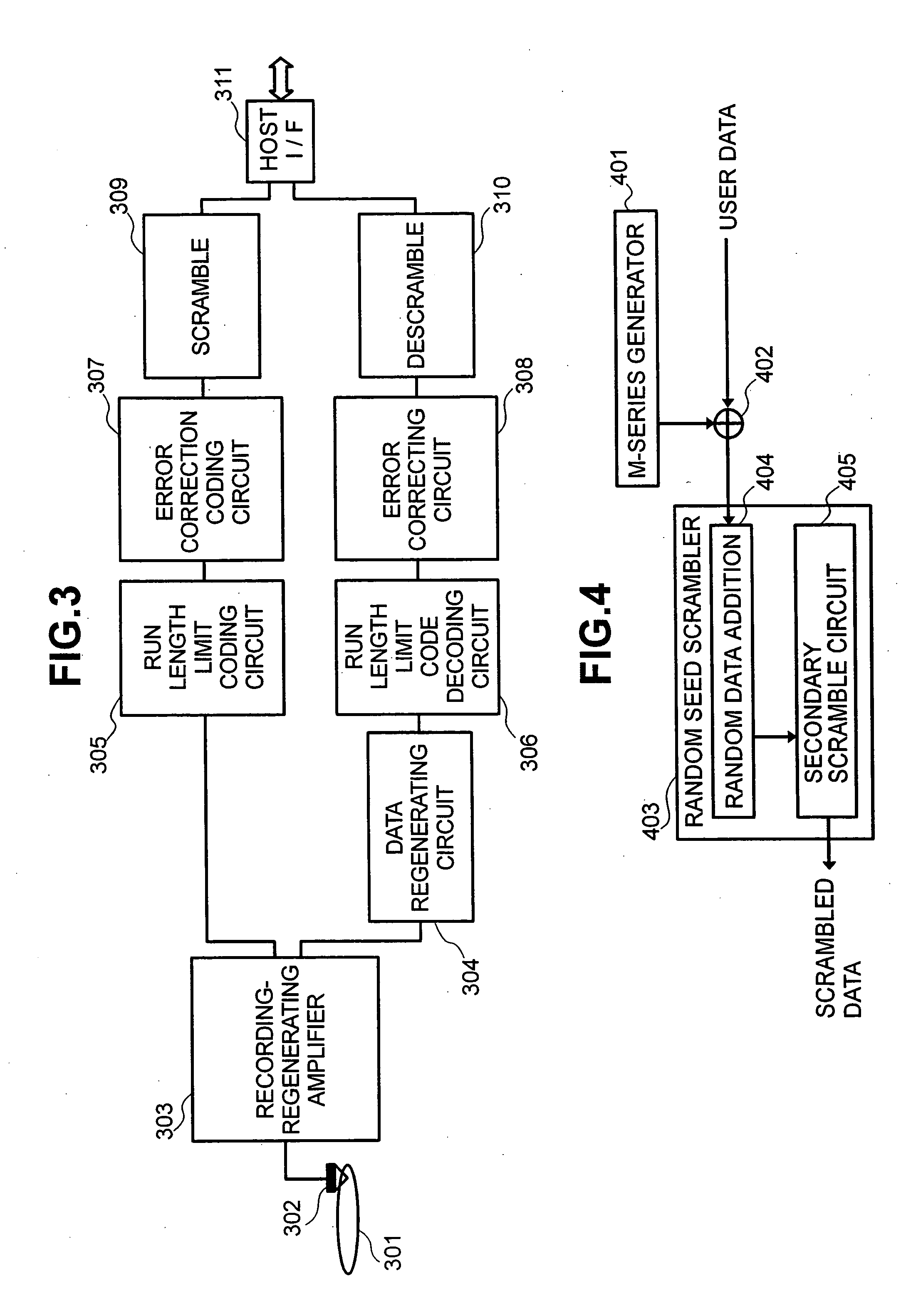Optical disk device and data randomizing method for optical disk drive
a technology of optical disk drive and optical disk device, which is applied in the direction of digital signal error detection/correction, coding, instruments, etc., can solve the problems of difficult to regenerate data with sufficient reliability in the memory device, tracking signal weakening, tracking is easily missed, etc., to increase the number of rewritable times of the memory medium, reduce the effect of format efficiency
- Summary
- Abstract
- Description
- Claims
- Application Information
AI Technical Summary
Benefits of technology
Problems solved by technology
Method used
Image
Examples
application example 1
[0287] When 32 sectors constituting this ECC data structure 5801 are sequentially set to first to 32nd sectors, the seed of 1 byte and the first to 32nd sectors of each 2048 bytes are continuously connected and are scrambled. A first byte of the data of this scramble result is arranged in the spare area. With respect to 1≦i≦32, 2048 bytes of (2048·(i−1)+2)-th to (2048·(i−1)+2049)-th bytes of the data of this result are treated as an i-th sector after the scramble, and 4 bytes of its EDC are added and these added data are arranged in a place for originally arranging the data of the i-th sector and its EDC (by the optical disk device of the first literature) in the ECC data structure 5801. Namely, with respect to 1≦i≦(32·2048), an (i+1)-th byte of the data of this result is arranged in a place in which the (i+1)-th byte of the data before the scramble should be originally arranged. A generated EDC is then added to this result (sector after the scramble). Next, similar to the original ...
application example 2
[0288] The seed of 1 byte, and 720 bytes before the error correction coding of the BIS area except for an arranging portion of the seed after the scramble described later (i.e., 719 bytes if the seed is arranged in 1 byte of the spare area, and plural bytes are removed from 720 bytes if the seed is arranged in the plural bytes), and first to 32nd sectors of each 2048 bytes are continuously connected and are scrambled. A first byte of the data of this scramble result is arranged in the spare area as the seed after the scramble. With respect to 1≦i≦(719+32 2048), an (i+1)-th byte of the data of this result is arranged in a place in which the (i+1)-th byte of the data before the scramble should be originally arranged, and an EDC generated with respect to this result is added. Next, similar to the original case, the error correction coding is performed in both the BIS area and the LDC area, and the ECC data structure 5801 obtained by this error correction coding is recorded similarly to...
application example 3
[0289] The seed of 1 byte and first to 32nd sectors of each 2052 bytes after the addition of the EDC are continuously connected and are scrambled. A first byte of the data of this scramble result is arranged in the spare area. With respect to 1≦i≦(32·2052), an (i+1)-th byte of the data of this result is arranged in a place in which the (i+1)-th byte of the data before the scramble should be originally arranged. Next, similar to the original case, the error correction coding is performed in both the BIS area and the LDC area, and the ECC data structure 5801 obtained by this error correction coding is recorded similarly to the original case.
PUM
| Property | Measurement | Unit |
|---|---|---|
| area | aaaaa | aaaaa |
| circumference | aaaaa | aaaaa |
| length | aaaaa | aaaaa |
Abstract
Description
Claims
Application Information
 Login to View More
Login to View More - R&D
- Intellectual Property
- Life Sciences
- Materials
- Tech Scout
- Unparalleled Data Quality
- Higher Quality Content
- 60% Fewer Hallucinations
Browse by: Latest US Patents, China's latest patents, Technical Efficacy Thesaurus, Application Domain, Technology Topic, Popular Technical Reports.
© 2025 PatSnap. All rights reserved.Legal|Privacy policy|Modern Slavery Act Transparency Statement|Sitemap|About US| Contact US: help@patsnap.com



